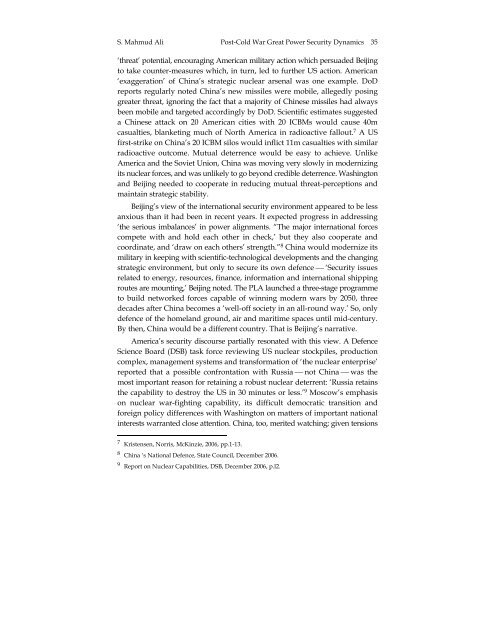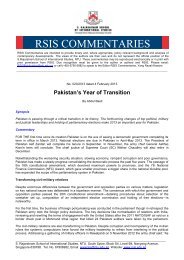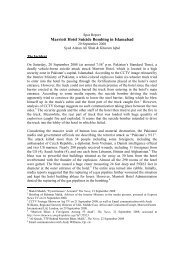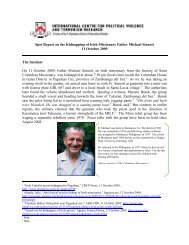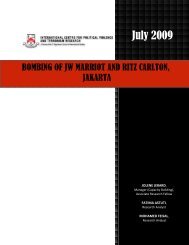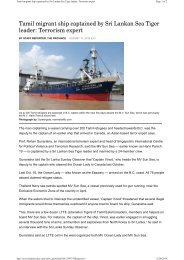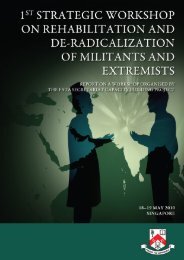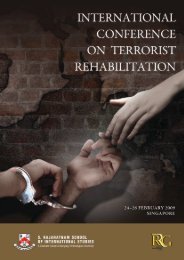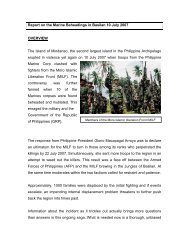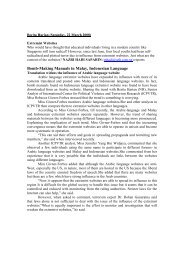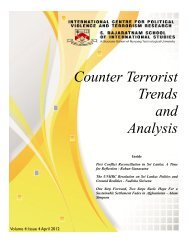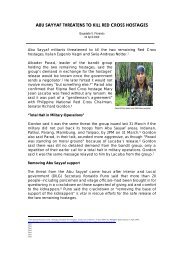Peace and Security Review, Vol.1 No. 2 - International Centre for ...
Peace and Security Review, Vol.1 No. 2 - International Centre for ...
Peace and Security Review, Vol.1 No. 2 - International Centre for ...
You also want an ePaper? Increase the reach of your titles
YUMPU automatically turns print PDFs into web optimized ePapers that Google loves.
S. Mahmud Ali Post-Cold War Great Power <strong>Security</strong> Dynamics 35<br />
‘threat’ potential, encouraging American military action which persuaded Beijing<br />
to take counter-measures which, in turn, led to further US action. American<br />
‘exaggeration’ of China’s strategic nuclear arsenal was one example. DoD<br />
reports regularly noted China’s new missiles were mobile, allegedly posing<br />
greater threat, ignoring the fact that a majority of Chinese missiles had always<br />
been mobile <strong>and</strong> targeted accordingly by DoD. Scientific estimates suggested<br />
a Chinese attack on 20 American cities with 20 ICBMs would cause 40m<br />
casualties, blanketing much of <strong>No</strong>rth America in radioactive fallout. 7 A US<br />
first-strike on China’s 20 ICBM silos would inflict 11m casualties with similar<br />
radioactive outcome. Mutual deterrence would be easy to achieve. Unlike<br />
America <strong>and</strong> the Soviet Union, China was moving very slowly in modernizing<br />
its nuclear <strong>for</strong>ces, <strong>and</strong> was unlikely to go beyond credible deterrence. Washington<br />
<strong>and</strong> Beijing needed to cooperate in reducing mutual threat-perceptions <strong>and</strong><br />
maintain strategic stability.<br />
Beijing’s view of the international security environment appeared to be less<br />
anxious than it had been in recent years. It expected progress in addressing<br />
‘the serious imbalances’ in power alignments. “The major international <strong>for</strong>ces<br />
compete with <strong>and</strong> hold each other in check,’ but they also cooperate <strong>and</strong><br />
coordinate, <strong>and</strong> ‘draw on each others’ strength.” 8 China would modernize its<br />
military in keeping with scientific-technological developments <strong>and</strong> the changing<br />
strategic environment, but only to secure its own defence ⎯ ‘<strong>Security</strong> issues<br />
related to energy, resources, finance, in<strong>for</strong>mation <strong>and</strong> international shipping<br />
routes are mounting,’ Beijing noted. The PLA launched a three-stage programme<br />
to build networked <strong>for</strong>ces capable of winning modern wars by 2050, three<br />
decades after China becomes a ‘well-off society in an all-round way.’ So, only<br />
defence of the homel<strong>and</strong> ground, air <strong>and</strong> maritime spaces until mid-century.<br />
By then, China would be a different country. That is Beijing’s narrative.<br />
America’s security discourse partially resonated with this view. A Defence<br />
Science Board (DSB) task <strong>for</strong>ce reviewing US nuclear stockpiles, production<br />
complex, management systems <strong>and</strong> trans<strong>for</strong>mation of ‘the nuclear enterprise’<br />
reported that a possible confrontation with Russia ⎯ not China ⎯ was the<br />
most important reason <strong>for</strong> retaining a robust nuclear deterrent: ‘Russia retains<br />
the capability to destroy the US in 30 minutes or less.’ 9 Moscow’s emphasis<br />
on nuclear war-fighting capability, its difficult democratic transition <strong>and</strong><br />
<strong>for</strong>eign policy differences with Washington on matters of important national<br />
interests warranted close attention. China, too, merited watching; given tensions<br />
7 Kristensen, <strong>No</strong>rris, McKinzie, 2006, pp.1-13.<br />
8 China ‘s National Defence, State Council, December 2006.<br />
9 Report on Nuclear Capabilities, DSB, December 2006, p.l2.<br />
<strong>Vol.1</strong>, <strong>No</strong>.2 2008 pp.27-47


